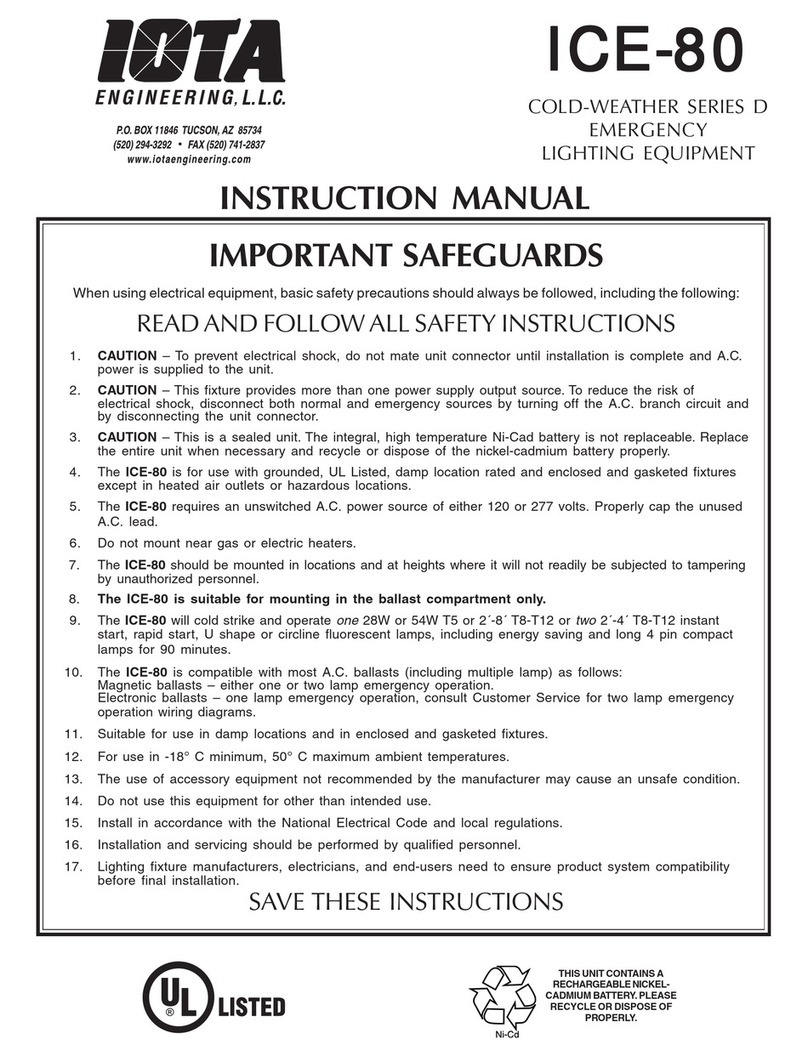
Page 4
68D20-109
REV 1901
Automatic Monthly Testing – The ILB-CP20-HE-SD-A will automatically conduct a 30 second test once every month. If
the ILB-CP20-HE-SD-A encounters a problem, the TBTS will flash RED. See the Table A below for diagnosis.
Automatic Annual Testing – The ILB-CP20-HE-SD-A will automatically conduct a 90 minute test every twelve months.
If the ILB-CP20-HE-SD-A encounters a problem, the TBTS will flash RED. See the Table A below for diagnosis.
To insure accurate testing, the ILB-CP20-HE-SD-A will not conduct any scheduled automatic tests or allow for manual
testing or calibration for a period of up to 24 hours after the unit has discharged, regardless of reason. This period is
easily indicated by the TBTS flashing green.
Failure Diagnosis - The ILB-CP20-HE-SD-A is designed to provide a general indication of where a fault in the emer-
gency lighting circuit may be located, based on the flashing failure code indicated by the TBTS.
Charge Failure - A fault is preventing the ILB-CP20-HE-SD-A from charging correctly. Please contact Customer
Service.
Battery Failure - The ILB-CP20-HE-SD-A battery is unable to fully charge, or was not able to supply sufficient
voltage to the LED load during a test. Please contact Customer Service.
Load Failure - The ILB-CP20-HE-SD-A has detected an issue with your LED load or the ILB-CP20-HE-SD-A
internal load transfer. If it can be verified that the LED load is operating correctly, please contact Customer
Service.
Note: in cases of multiple failures only the highest priority failure will be indicated. Charge Failure is the highest priority
failure, followed by Battery Failure, followed by Load Failure.
LED IS FLASHING GREEN WHEN CHARGING, SOLID GREEN WHEN READY. FAILURE CODES ARE
INDICATED BY THE RED LED
CHARGE FAILURE
BATTERY FAILURE
LOAD FAILURE
1 FLASH
2 FLASHES
3 FLASHES
FAILURE CODES OCCUR ONCE EVERY
15 SECONDS. ONLY HIGHEST PRIORITY
FAILURE IS INDICATED.
CANCEL 90-MINUTE TEST
30-SECOND TEST
90-MINUTE TEST
1 X PRESS AND RELEASE
PRESS AND HOLD
2 X PRESS AND RELEASE
A LOAD CALIBRATION CAN ALSO BE PERFORMED BY DISCONNECTING AND RECONNECTING THE UNIT CONNECTOR
ILB-CP-HE-SD MANUAL TESTING SEQUENCES
LOAD CALIBRATION
1
1
TOGGLE = SWITCHING TO ON STATE OR OFF STAT E
2
WALL SWITCH TESTING IS NOT RECCOMMENDED FOR PHASE-DIMMING APPLICATIONS
3
UNIT CONNECTOR MUST BE CONNECTED
4
2
3
4
QUICK TEST
3 X PRESS AND RELEASE
4 X PRESS AND RELEASE
TBTSTEST TYPE WALL SWITCH MINIMUM BATTERY CHARGE REQUIREMENTS
N/A
6 TOGGLES
8 TOGGLES
4 TOGGLES
N/A
2 HOURS
24 HOURS
24 HOURS
24 HOURS
ILB-CP-HE-SD MANUAL TESTING SEQUENCES - CANCELLING TEST
TBTSTEST TYPE WALL SWITCH MINIMUM BATTERY CHARGE REQUIREMENTS
UNIT MUST BE IN SELF-TEST MODE
CANCEL 90-MINUTE TEST
30-SECOND TEST
90-MINUTE TEST
1 X PRESS AND RELEASE
PRESS AND HOLD
2 X PRESS AND RELEASE
A LOAD CALIBRATION CAN ALSO BE PERFORMED BY DISCONNECTING AND RECONNECTING THE UNIT CONNECTOR
ILB-CP-HE-SD MANUAL TESTING SEQUENCES
LOAD CALIBRATION
1
1
TOGGLE = SWITCHING TO ON STATE OR OFF STAT E
2
WALL SWITCH TESTING IS NOT RECCOMMENDED FOR PHASE-DIMMING APPLICATIONS
3
UNIT CONNECTOR MUST BE CONNECTED
4
2
3
4
QUICK TEST
3 X PRESS AND RELEASE
4 X PRESS AND RELEASE
TBTSTEST TYPE WALL SWITCH MINIMUM BATTERY CHARGE REQUIREMENTS
N/A
6 TOGGLES
8 TOGGLES
4 TOGGLES
N/A
2 HOURS
24 HOURS
24 HOURS
24 HOURS
ILB-CP-HE-SD MANUAL TESTING SEQUENCES - CANCELLING TEST
TBTSTEST TYPE WALL SWITCH MINIMUM BATTERY CHARGE REQUIREMENTS
UNIT MUST BE IN SELF-TEST MODE
Manual Testing - Manual Testing can be performed on the ILB-CP20-HE-SD-A, provided the unit is fully charged, by
pressing and releasing the TBTS or engaging the wall switch that controls the emergency luminaire. Manual Testing
cannot be initiated until the unit has received a full 24 hour charge. Manual Testing will not interfere with the automatic
testing schedule of the ILB-CP20-HE-SD-A and will display the same diagnosis indicators as automatic testing. Activate
the desired test using the sequences in Table B below:
Table A:TBTS Self-Diagnostic codes
Table B: Manual Test Sequences
Table C: Cancel a Test
For more information on diagnosing ILB-CP20-HE-SD-A failure codes, contact Customer Service.
SERVICING SHOULD BE PERFORMED BY QUALIFIED PERSONNEL.
Consult Customer Service for current warranty information.























